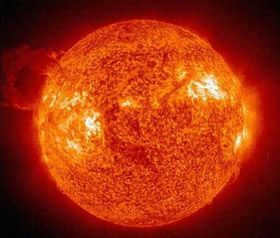
The Sun is the solitary star located in the Solar System, encompassing all of its planets, along with their moons and other celestial bodies, even down to the interstellar debris. In terms of mass, the Sun accounts for approximately 99.866 percent of the entire solar system.
The Sun is just one out of the 100,000,000,000,000 stars within our galaxy and ranks as the fourth largest among them. The nearest star to the Sun, Proxima Centauri, lies at a distance of four light-years from Earth. The Sun is situated 149.6 million kilometers away from planet Earth, with its light taking eight minutes to reach us. It is positioned 26 thousand light years away from the center of the Milky Way galaxy and completes one revolution around it every 200 million years.
Presentation: The Sun
Based on the star’s spectral classification, it is categorized as a “yellow dwarf”. Rough estimates suggest that the Sun is approximately 4.5 billion years old, placing it in the middle of its lifecycle.
The Sun’s Composition
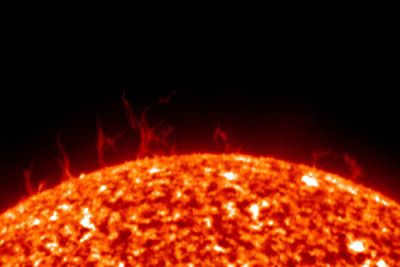
The Sun has an intricate composition, consisting of 92% hydrogen and 7% helium. Its structure is highly intricate, with a core at its center. The core, which makes up around 25% of the star’s total radius, has a radius of approximately 150,000-175,000 km. The temperature at the core reaches an astonishing 14,000,000 K.
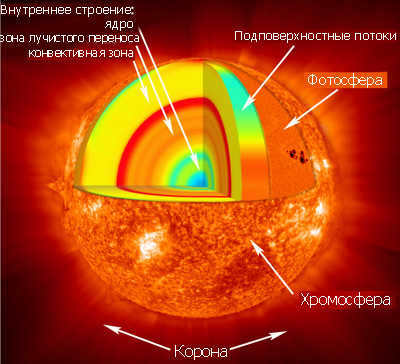
The innermost part of the star, known as the core, spins rapidly on its axis at a rate much faster than the outer layers. Within this core, a process called helium formation occurs, where four protons combine to create helium. This reaction releases a significant amount of energy which then travels through all layers of the star and is ultimately emitted from the photosphere as both light and kinetic energy. Located above the core is the radiative transfer zone, where temperatures range from 2 to 7 million K. Beyond this zone is a convective zone that spans about 200,000 km in thickness. In this convective zone, energy is transferred through plasma mixing rather than re-radiation. Finally, at the surface of the star, the temperature is approximately 5800 K.
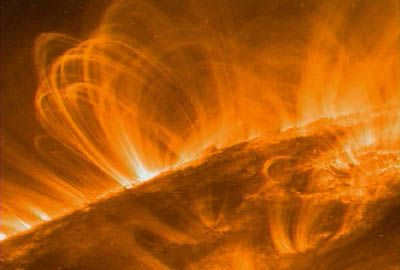

The Sun is composed of different layers, including the photosphere, which is the visible surface of the star. Another layer is the chromosphere, which has a thickness of around 2000 km. The outermost layer is known as the corona, which has an incredibly high temperature ranging from 1,000,000 to 20,000,000,000 Kelvin. It is from this outer part of the corona that ionized particles called the solar wind escape into space.
The Sun’s Evolution
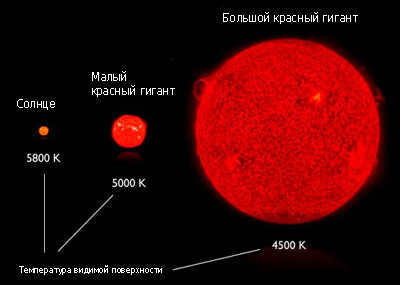
The Sun is expected to undergo significant changes in approximately 4 to 5 billion years, when it reaches an age of around 7.5 to 8 billion years. At this stage, the star will transform into a red giant, expanding its outer shells to the point where they may extend as far as Earth’s orbit. This expansion could potentially result in the displacement of the planet, pushing it further away from its current position.
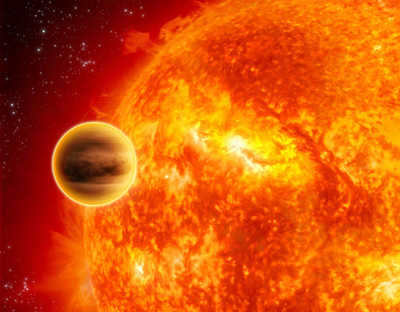
In the face of extreme heat, the existence of life as we presently comprehend it will become utterly impracticable. The Sun will conclude its lifecycle as a “white dwarf”.
The Sun serves as the origin of life on our planet

The Sun serves as the primary source of warmth and energy, which is essential for supporting life on Earth. Due to the rotation of our planet, we are able to witness the majestic sunrise and breathtaking sunset on a daily basis. Additionally, during the nighttime, when certain areas of the Earth are immersed in darkness, we are able to marvel at the beauty of the stars that adorn the night sky.
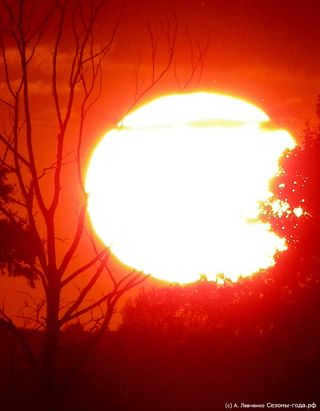
The sun plays a significant role in the essential functions of the Earth. It is responsible for photosynthesis and aids in the production of vitamin D in the human body. The solar wind can trigger geomagnetic storms, and its interaction with the Earth’s atmosphere results in the magnificent natural phenomenon known as the aurora borealis, or the northern lights. Solar activity fluctuates in a cyclical pattern, with periods of decrease and increase occurring approximately every 11 years.
Exploring the Sun
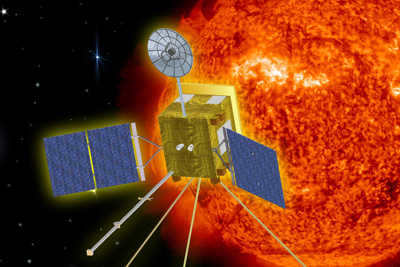
Ever since the dawn of the space era, scientists have held a keen fascination with the Sun. Advanced telescopes featuring dual mirrors are employed for professional observation, and international initiatives have been established. However, the most precise information can only be gathered beyond the Earth’s atmosphere, which is why studies are primarily conducted from satellites and spacecraft. The first such investigations were conducted as early as 1957 across various spectral ranges.
Nowadays, miniature observatories called satellites are sent into space to gather fascinating data about stars. In the early days of human space exploration, multiple spacecraft were created and launched specifically to study the Sun. The first batch of these satellites was launched by the United States in 1962. In 1976, the West German Helios-2 was successfully launched, marking the first time in history that a spacecraft approached the Sun at a distance as close as 0.29 astronomical units. During its mission, the Helios-2 recorded the presence of helium nuclei in solar flares and detected magnetic shock waves with frequencies ranging from 100 Hz to 2.2 kHz.
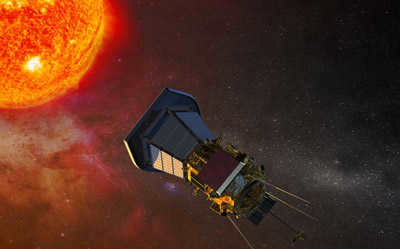
The Ulysses solar probe, which was launched in 1990, is another fascinating device. It has been placed in an orbit near the Sun and moves in a direction perpendicular to the ecliptic plane. After eight years of its launch, the spacecraft completed its first revolution around the Sun. It observed the spiral pattern of the Sun’s magnetic field and documented its continuous growth.
NASA has plans to launch the Solar Probe+ in 2018, which will approach the Sun at the closest distance possible – 6 million kilometers (7 times closer than Helius-2). It will orbit the Sun in a circular path. To protect the probe from extreme temperatures, it is equipped with a shield made of carbon fiber.
Closest neighbors.
To establish the rightful position of our Sun among the celestial bodies, let’s initially examine its immediate surroundings. The Sun’s closest neighbor is a trinary star system, consisting of three stars in mutual orbit. The most prominent of these stars, Alpha Centauri A, closely resembles our own Sun in terms of its yellow hue. Alpha Centauri B, on the other hand, is slightly smaller and emits a slightly cooler orange glow due to its lower surface temperature of approximately 4800 °C, whereas the Sun’s temperature reaches 5800 °C. The color of a star provides insights into its temperature, with cooler stars appearing red, while hotter stars display shades of orange, yellow, and bluish-white.
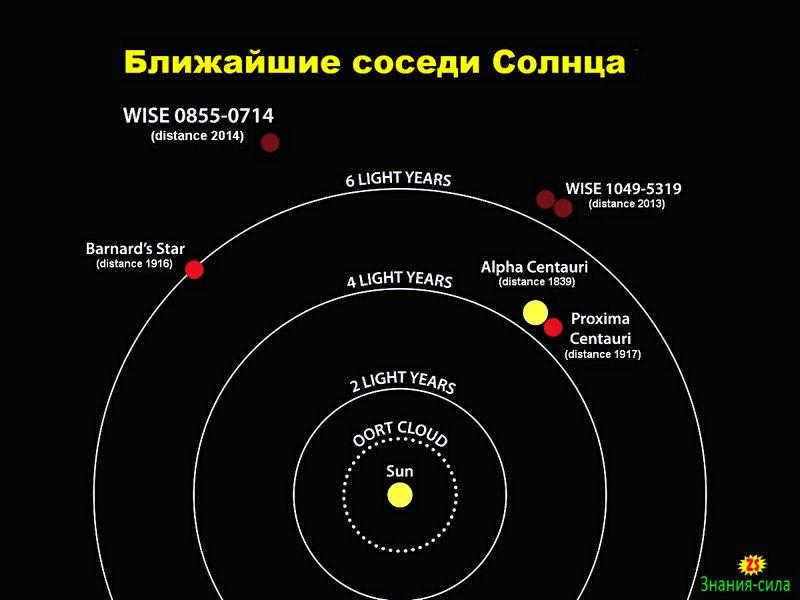
The stars that are nearest to our Sun
The Alpha Centauri system’s two primary stars have an orbital period of approximately 80 years. They are positioned at a significant distance apart, comparable to the distance between the Earth and the Sun or from the Sun to the planet Uranus. The system’s third star, known as Alpha Centauri C or Proxima Centauri, earns its name due to its status as the closest star to Earth. Despite being dim, red (and therefore cold), and small, Proxima Centauri represents a more typical star. It resides far from the primary pair, approximately 300 times the distance from the Sun to Pluto. If our Sun had a companion star resembling Alpha Centauri C, it would resemble an ordinary star in the night sky. It would be visible to the naked eye but wouldn’t stand out from other stars, appearing dimmer.
The Star of Barnard
Our close cosmic neighbor is also known as Barnard’s star, which was named after Edward Emerson Barnard, a renowned astronomer from a century ago. This unassuming little star is located in the direction of the Serpens constellation. It is the closest star that can be observed from the northern hemisphere using telescopes, although only a select few astronomers are currently studying it. Barnard’s star bears a striking resemblance to Proxima Centauri and is classified as a red dwarf, which is the most prevalent type of star in our galaxy.
One particular star that we examined was not eager to disclose its mysteries. There was an abundance of flares to observe during one year, but the following year, they were almost non-existent. I recall jotting down in my notebook, “Could the behavior of this star resemble the 11-year cycle of the Sun?” It’s possible.
Barnard’s star has a rapid apparent movement across the sky, making it the fastest-moving star. However, due to its small size, this star’s motion doesn’t have an impact on the shape of constellations. Constellations appear to be unchanging, at least from the perspective of humans and their relatively short lifespans. However, over the course of centuries, stars gradually shift their positions in space. For instance, our Sun and the planets of the solar system take about 200 million years to complete an orbit around the center of the galaxy. This process occurs so slowly that constellations that are 10,000 years old remain largely recognizable. Nevertheless, if a modern astronomer were somehow transported back in time one million years and looked up at the night sky, they would be bewildered. Barnard’s star moves across the sky at a rate of half a degree every 175 years. It is currently approaching and is projected to be in close proximity to Earth around the year 11800, just four light-years away (which is closer than Proxima Centauri).
Several years ago, certain astronomers had the belief that Barnard’s star had a planet in its orbit. Observations indicated that as the star traversed the sky, it exhibited a slight wobbling motion along its vertical axis. It is plausible that this wobble was a result of the gravitational pull from one or more sizable planets located nearby. However, conclusive evidence could not be obtained, and the star’s wobble was barely discernible. Over the past decade, a revelation has been made that there are numerous planets orbiting their respective stars in the vicinity of our solar system. This implies that the universe is teeming with planets, rendering it a commonplace occurrence.
Other neighboring stars
There exists an additional red dwarf in close proximity to our solar system that has gained fame due to the television series Star Trek. This particular star is commonly referred to as Wolf 359. The Borg, a highly advanced group of cyborgs controlled by a singular consciousness, have also played a role in making this star well-known. Wolf 359 is situated within the Leo constellation and is the faintest among its neighboring stars, as well as one of the dimmest stars ever discovered. If Wolf 359 were to replace our Sun, the Earth would experience either complete darkness or illumination equivalent to only ten times the brightness of moonlight.
Where are we headed?
In 1783, William Herschel made observations that led to the discovery of solar motion. He concluded that our solar system is in motion towards a star known as Lambda Hercules, or Maasim in Arabic, which translates to “wrist”. To describe this direction, Herschel coined the term “apex” (derived from the Latin word “arechus” meaning “top”), which refers to a point on the celestial sphere indicating the direction in which an astronomical object is moving. The brightest star in the sky, Sirius, represents the antiapex or the point from which the Sun is moving away.
This is the direction of the Sun’s movement around the center of the Milky Way. All of the 100,000 stars in our galaxy orbit around the central point. The speed of a star’s movement depends on its proximity to the galaxy’s center. The Sun, for example, is located 24 thousand light years away from the center and moves at a rate of 220 km/s, completing a full orbit every 230 million years. This means that over its lifetime, the Sun has made approximately 18 revolutions around the Galaxy (some data suggests 25-30 revolutions). In addition to its circular motion, the Sun also oscillates up and down relative to the Galaxy’s plane. This oscillation occurs every 70 million years, meaning that we pass through the median plane of the Galaxy every 35 million years. Some scientists have compared this timeframe to the intervals between mass extinctions on Earth. It is well-known that the Earth has been experiencing an increase in cosmic ray exposure over the past 100,000 years as it approaches the median plane of the Galaxy. It is possible that this phenomenon could impact cloud cover and subsequently alter the Earth’s climate.
Our Milky Way galaxy consists of a sequence of spiral arms, and our Sun is currently located in a small spiral arm called Orion, which connects the larger spiral arms of Sagittarius and Perseus. Every 100 million years, Earth traverses through the primary spiral arm, with the duration of this passage lasting for 10 million years. As Earth passes through the spiral arm, it experiences an increased influence from the nearest supernova, whose intense radiation can even impact Earth’s climate from distances spanning tens of light-years.
Proxima Centauri, also known as Alpha Centauri C, is a red dwarf star that belongs to the Alpha Centauri star system. It holds the distinction of being the closest star to the Sun, with the name “Proxima” derived from the Latin word for “closest”.
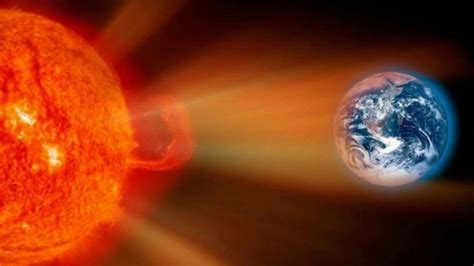
Table of Contents:
- Which celestial body is closer to Earth, the Moon or the Sun?
- What is the name of the star that sustains life on Earth?
- Which bright star is nearest to the Sun?
- What is in closer proximity to Earth?
- What is the smallest star in the universe?
- What is the estimated value of the entire planet?
- Which star is always visible in the night sky?
- How many planets are there in space?
- Between Venus and Mars, which is nearer to Earth?
Is the moon or the sun closer to Earth?
According to the system, the Moon is approximately 400 times closer to Earth than the Sun. The average distance from the center of the Earth to the center of the Moon is 380,000km = 0.0026AE.
What is the name of the star closest to us in distant space?
The closest star to Earth (excluding the Sun) is Proxima Centauri, which was discovered in 1915. It is located approximately 4.2 light-years away from Earth. A light-year is the distance that light travels in one year.
Which is the largest star in the world?
| HV 2112 | 918 |
| Betelgeuse (Alpha Orion) | 887 + 203 — 1200 |
| V602 Kiel | 860 |
| Antares | 800 — 900 |
What is the object situated on the side of the moon? Take note of the celestial body Aldebaran (also known as Alpha Taurus, with an apparent magnitude of +0.85) located to the right and below the Moon, in close proximity to the Hyades cluster. This phenomenon can be observed using the naked eye or binoculars.
How many celestial bodies of the planetary nature are truly present in our solar system?
According to the standards set by the International Astronomical Union, there exist a total of 8 planets within our solar system. Arranged in order of their distance from the Sun, these planets consist of four Earth-like entities: Mercury, Venus, Earth, Mars, followed by four giant planets: Jupiter, Saturn, Uranus, and Neptune.
What is the name of the star that provides life to our planet?
The answer is quite obvious – the Sun, which happens to be the only star in our solar system.
What is the name of the most brilliant star?
The most brilliant star, apart from the Sun, is Sirius.
What is the celestial body that is nearest to Earth?
Most of the time, the celestial body that is closest to our planet is… Mercury! Let me provide you with more details: on average, Mercury is the nearest to any planet in the entire solar system.
Which space object is closest to our planet?
The Moon, a natural satellite, is the nearest celestial body to Earth. It completes a full revolution around our planet in 28 days. It is the second brightest object in the Earth’s sky, right after the Sun, and it is also the fifth largest natural satellite of any planet in the solar system. The average distance between the centers of the Earth and the Moon measures 384,467 km.
Which star is located near the Sun?
What is the nearest planet to Earth?
Indeed, the closest planet to Earth is Mercury. However, it is not only surprising for this reason. On average, Mercury is the closest planet not just to Earth, but also – consider this – to any other planet in the Solar System!
What is the very first star?
| A binary star system. | |
| Sirius A and B. Image captured by the Hubble telescope. | |
| Research history | |
| Discoverer | Known since ancient times |
What is the tiniest star in existence?
Astronomers have identified the star EBLM J0555-57Ab as the smallest star currently known in the entire Universe. This particular star is even smaller than Saturn (which has a diameter of just over 116,000 kilometers), and if it had less mass, it would be categorized as a brown dwarf.
Which planet holds the title for being the coldest in the world?
That honor goes to Uranus, which happens to be 1.7 billion kilometers closer to the Sun. Among all the planets in our solar system, Uranus boasts a minimum temperature of minus 224°C.
Which planet is the largest in the world?
The solar system’s largest planet, Jupiter, will undergo a celestial alignment with the Sun on June 10. This alignment occurs when a planet lies on a direct line connecting the Earth and the Sun, with the Earth positioned in between the planet and the Sun.
What is the total value of the entire planet?
Greg Laughlin, an astrophysicist at the University of California, Santa Cruz, has come up with his own formula to estimate the value of planet Earth. According to his calculations, it is valued at 5 quadrillion dollars. In terms of rubles, that amount is equivalent to ₽380,394,500,000,000,000,000,000.
Mira (ο Cet, Omicron Cetus) is a binary star system located in the constellation Cetus. It consists of a red giant named Mira A and a white dwarf named Mira B. The distance to Mira is estimated to be around 417 light-years with an uncertainty of ± 14%.
How many planets exist in our galaxy?
Based on certain calculations, it is believed that there may be an average of 800 billion to 3.2 trillion planets in the Milky Way that could potentially support life. However, some experts speculate that the number could be as high as eight trillion.
What is the celestial body known as the star of Love?
Cassiopeia (Latin: Cassiopeia) is a group of stars forming a constellation in the sky of the Northern Hemisphere.
Which celestial body is constantly visible?
Sirius, also known as the Alpha Canis Majoris, is the most luminous star that can be seen with the naked eye in the night sky, with an apparent magnitude of -1.46.
What is the designation of the largest star in the cosmos?
The largest star known to mankind is VY Canis Majoris, also referred to as VY CMa, which is located 5 light years away from Earth and has a diameter of 2.9 billion kilometers, making it approximately 1,800 times bigger than the Sun.
How many total planets exist in space?
| Number of known planets | 8 |
| Number of dwarf planets | 5 |
| Number of satellites | 639 (204 for planets and 435 for small solar system bodies) |
| Number of small bodies | More than 1,000,000 (as of November 2020) |
What are the nearest stars to Earth?
Among the stars closest to us, only 3 are of first magnitude: Sirius, Alpha Centauri, and Procyon, with the closest star to Earth being a red dwarf.
Which planet is the hottest?
Venus has an average surface temperature of 735 K (462 °C), making it the hottest planet in the solar system, despite Mercury being closer to the Sun.
Which planet is the smallest?
Mercury is known as the smallest planet in our solar system. It has a radius of approximately 2,440 kilometers, which is equivalent to one-third of Earth’s width. In comparison, the Moon has a slightly larger radius of around 1,609 miles. Following Mercury, the next smallest planet is Mars, with a radius of about 3,389 kilometers.
Which star is the most radiant when observed from Earth?
Sirius, located in the Canis Major constellation, holds the title for the brightest star visible in the night sky. With an apparent magnitude of -1.47m, Sirius shines the brightest among all the stars. In the Northern Hemisphere, Sirius can be seen as the apex of the Winter Triangle, alongside the prominent stars Betelgeuse and Procyon.
What is the name of the first star that appears in the sky?
Is it the first celestial body to appear in the sky after sunset and increases in brightness as the night progresses, shining as the most luminous object above the western horizon? Undoubtedly, it is the planet Venus! The most brilliant celestial body in our sky after the Moon and the Sun! It can be observed in either the morning or evening sky.
Which celestial body is closer to Earth, Venus or Mars?
The distance between Earth and Venus ranges from 38 million to 261 million kilometers, while the distance between Earth and Mars ranges from 54 million 60 thousand to 400 million kilometers. Therefore, Venus is the celestial body that is closest to Earth.
How far does light travel to reach the Moon?
The average distance to the Moon is approximately 380,000 kilometers. This means that a beam of light emitted from the surface of the Earth would take about 1.3 seconds to reach the surface of the Moon.
What is the lifespan of a star?
Did our responses provide assistance?
Currently trending in the past 24 hours

What impact does the date of birth have on an individual’s character?
Numerology utilizes the concept of a “Character Number” to identify and evaluate a person’s traits. It delves deeper into the influence of the date of birth on character development.

What are the signs that he doesn’t care about you?
To have self-respect means to acknowledge and prioritize what you consider valuable and significant. This starts with valuing yourself.

What is the significance of having multiple units in a date of birth?
As per numerologists, the presence of repeated numbers in an individual’s date of birth can hold meaning.

What is the maximum number of times a man can fertilize a woman?
The equation is as follows: 72’000’000 * 0.75 * 365 * (70 – 14) = 1’103’760’000’000 fertilized eggs.

What is the name of the closest to the sun planet?
Xiuzai is determined by three factors. Firstly: the consciousness number is derived from your date of birth. To discover your ts.

What is the interpretation of the 7th Arcana in the matrix of destiny?
The twenty-two Major Arcana cards in the Tarot symbolize the different phases of personal growth, with each card holding its own significance.


What is the correct way to sum up the date of birth?
In order to calculate the life path number, you need to sum up all the elements of the complete date of birth: both the day and the month.

Which date of birth is the most common worldwide?
Not surprisingly, the least common birthday is February 29, which occurs only once every four years.

What is the name of the closest star to the sun?
To determine your fortunate number, you must add the digits from your date of birth. For instance, the date of birth 06/15/1990 would be calculated as follows: 0 + 6 + 1 + 5 + 1 + 9 + 9 + 0 = 31. In this case, the lucky number would be 31.

What is the name of the closest to the Sun?
Repdigit (repdigit, from repeated digit), also known as repdigit, refers to a single digit that is repeated.

The presence of the Sun, our primary source of light and heat, is crucial for the existence of life on planet Earth. The physical and climatic conditions that make our civilization possible are greatly influenced by the unique balance provided by the Sun. Without it, our world would be drastically different.

Throughout the past 4.5 billion years, the Sun has consistently risen on the horizon and then set in the west after a duration of 8 to 18 hours.
What we understand about the Sun
For a period of 4.5 to 5 billion years, the Earth and the Sun have been inextricably linked. Throughout this time, our planet has been an integral part of the solar system, moving steadily within its orbit around the central star. With its nearly circular orbit, the Earth provides us with regular access to sunlight and the comforting warmth emitted by our nearest star. At its farthest point from the Sun, known as aphelion, the Earth is situated 152 million kilometers away from the central luminary. In contrast, at its closest point, known as perihelion, the Sun draws nearer to us by a margin of 5 million kilometers. The average distance between the two celestial bodies is approximately 147 million kilometers.
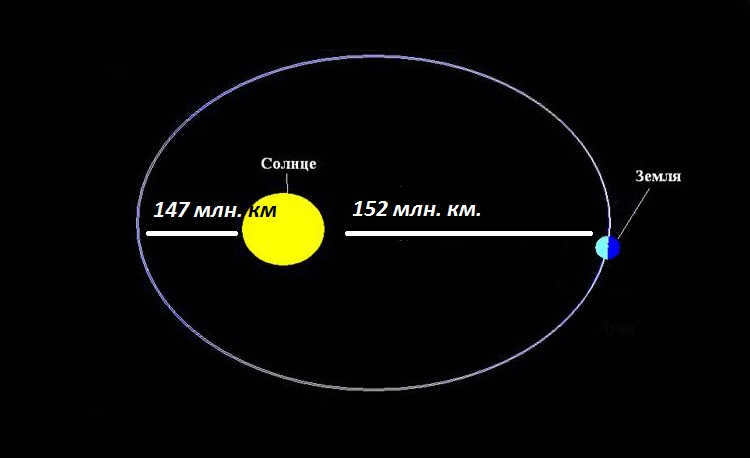
The position of the Earth’s orbit around the Sun varies throughout the year. When the Earth is at aphelion, it is at its farthest distance from the Sun, approximately 152 million km. On the other hand, during perihelion, the Earth comes closest to the Sun, at a distance of around 147 million km.
Our knowledge about the Sun is vast. Since ancient times, people have been fascinated by this celestial body. Apart from being considered divine, the Sun has also played a crucial role in determining time. Ancient Egypt used solar calendars, while Native Americans relied on the Sun to create their own calendars. Even in modern times, our civilization follows a chronology that is based on the movement of this central luminary of our solar system.
Scientists were only able to obtain more precise astrophysical parameters about the closest star to us with the introduction of specialized instruments, tools, and devices. As anticipated, the Sun, a warm and gentle celestial body, is an immense gaseous fireball, a cluster of gas glowing at temperatures of up to a million degrees. To study this radiant object, a spectrograph and spectroheliograph, coronagraph, and radio telescopes were utilized. It is not feasible to observe the luminous star with a conventional telescope. Only through images captured by automated space probes and photographs taken by the Hubble Space Telescope have we been able to obtain a visual representation of the Sun’s surface.
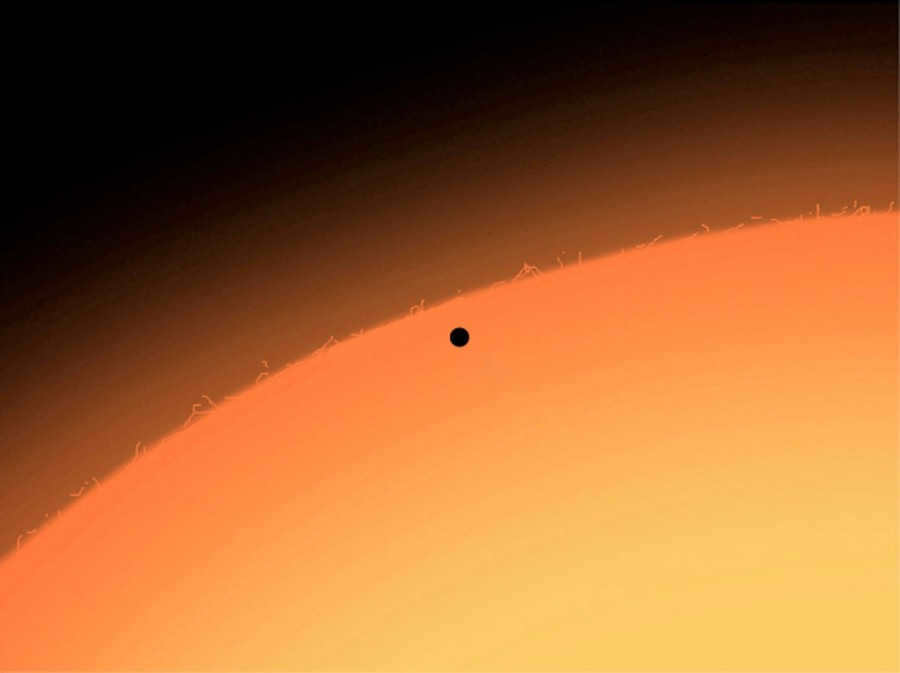

When observed from Earth through an optical telescope, the solar disk appears as Mercury passes through it.
From our perspective on Earth, the Sun may not seem as large as it actually is. The visible solar disk has a diameter of only 50-70 centimeters. However, if we were to observe the Sun from distant Pluto, our central star would appear as just another bright star in the night sky, among hundreds of thousands. On the surface of Mercury, the opposite would be true. The solar disk would dominate almost two-thirds of the planet’s sky, radiating intense heat onto its surface.
Astrophysical Characteristics of the Sun
The Sun, the central star of our solar system, is truly immense in size compared to the other celestial bodies within it. In fact, its volume is a staggering 1.3 million times larger than that of the Earth. To put it into perspective, all of the planets in our solar system, including the massive Jupiter, Saturn, and Neptune, could easily fit within the boundaries of the Sun. The volume of the Sun is approximately 1.40927 x 10^7 cubic meters. With such a significant volume, it comes as no surprise that the Sun also possesses an enormous mass. Its mass is approximately 1.9885 x 10^30 kilograms, which is 332,000 times greater than the mass of our planet. In fact, the Sun’s mass surpasses the combined mass of all the planets, satellites, asteroids, and comets in our solar system. In terms of density, the Sun, being composed of glowing gas, has a lower density compared to Earth, with a density of 1.409 grams per cubic centimeter versus Earth’s density of 5.51 grams per cubic centimeter.
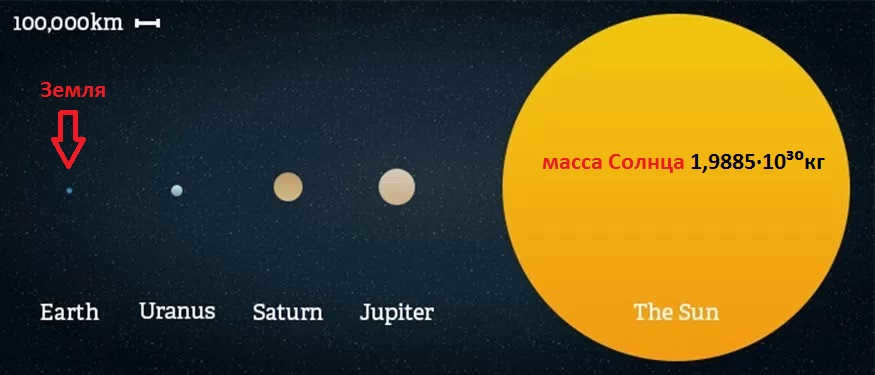
When comparing the size of the Sun to the planets in our solar system, it becomes clear just how massive our star is. In fact, it would take an astonishing 1 million 300 thousand Earths to match the size of the Sun.
With a diameter of 1 million 384 thousand kilometers, the Sun is truly a behemoth. To put it into perspective, this measurement is equivalent to four times the distance between the Earth and the Moon. As the center of the Solar System, the Sun governs the movements of 8 major planets, 5 dwarf planets, and 184 natural satellites. Additionally, there are also countless asteroids and comets with short orbital periods that make up this vast celestial neighborhood.
If we consider our star as the primary and central entity that governs the motion of planets and other celestial bodies in the solar system, then in the context of the galaxy, the Sun appears insignificant, comparable to a minuscule particle of dust.
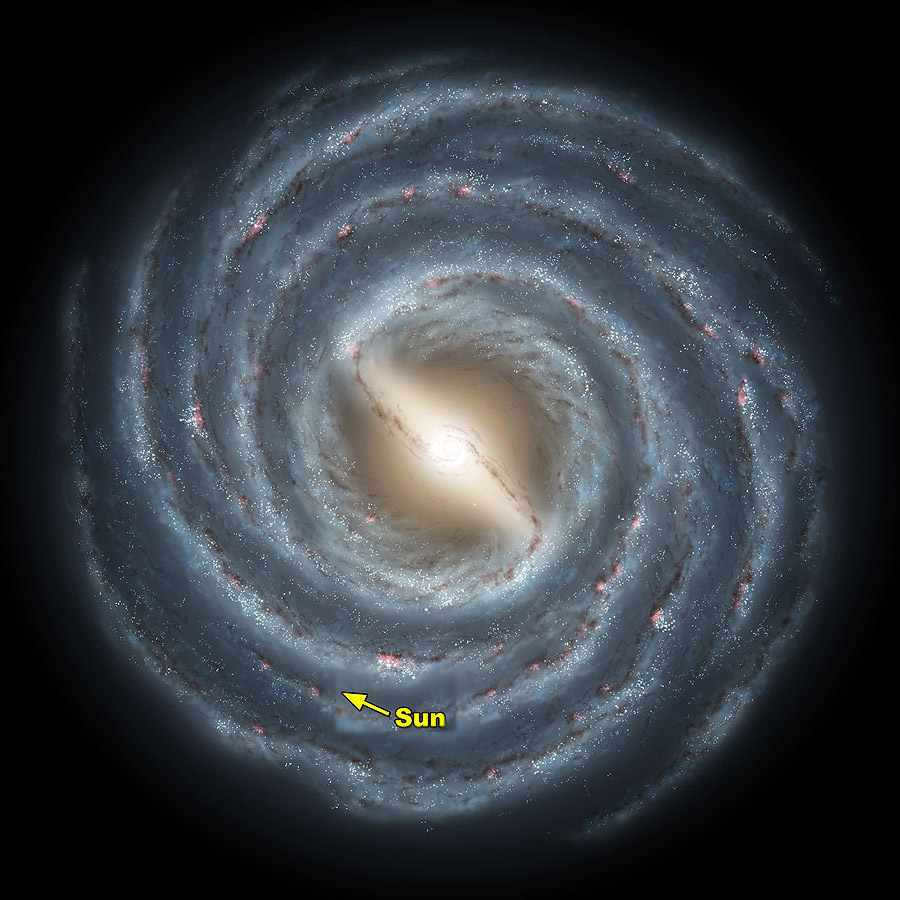
The Sun is positioned within the Sagittarius arm of the Milky Way Galaxy, which is one of its four massive arms. This colossal spiral galaxy has a diameter ranging from 100,000 to 120,000 light-years, with a thickness of approximately 1000 light years. Through detailed studies, scientists have determined that the Sun and its retinue of stars are located about 26 thousand light years away from the galaxy’s center.
Scientists say that this particular area of the galaxy is known for its peacefulness, unlike the central regions of the Milky Way. The clusters of stars in this region are not densely packed, allowing for a balanced and stable gravitational environment. This is evident in the long and quiet existence of our solar system for billions of years. In the grand scheme of things, the Sun is a relatively small celestial body. It falls into the category of yellow dwarf stars, which are known for their calm and steady stellar lifespans. In terms of its visible spectrum, the Sun is classified as a G2V star.
Because of the vast amounts of interstellar gas and cosmic dust, determining an exact stellar address for the Sun and our solar system is an impossible task. However, advancements in astrophysics in the 20th century allowed scientists to capture images of the galaxy from various perspectives, enabling them to construct a three-dimensional model of the Milky Way and gain a more precise understanding of the Sun’s position.

The Sun is surrounded by various celestial objects that reside within the Sagittarius-Swan arms.
The detailed model provides a clear depiction of the vicinity of our star and its surrounding environment. The closest neighbor to the Sun is the red dwarf Proxima, which is part of the Alpha Centauri triple star system. Traveling to this star would take approximately four light-years. The well-known Sirius, familiar to astronomers, is twice as distant, located eight light-years away from our solar system. Currently, the nearest large star is the red supergiant Betelgeuse, positioned at a distance of 570 light-years from us.
The Sun star’s speed and orbital parameters are as follows:
- The speed of the Sun as it orbits around the central region of the Milky Way galaxy is 217 km/s.
- The complete revolution period of our star around the galaxy’s center is approximately 226 million years.
- Throughout its lifetime, the Sun has completed a total of 20 revolutions around the center of the galaxy.
In terms of its age, the Sun is currently in the middle of the main sequence, indicating that it is in its mature stage. In approximately 4-5 billion years, the Sun will undergo a transformation and become a red giant, gradually fading away to eventually become a white dwarf. It is possible that in billions of years, the Universe will witness a supernova explosion, causing the Sun to vanish from the celestial map.

The position of the Sun on the main sequence corresponds to the spectral luminosity class G
The Sun’s Composition: a brief description of the star’s outer layers
Speaking of the star itself, our Sun falls into the category of typical stars that can maintain stability for an extended period due to its mass. The visible outer layer of the star is known as the photosphere, which emits radiation. This layer is several hundred kilometers deep and is situated just behind the convection zone. The photosphere serves as the source of solar radiation, which spreads out in all directions into outer space. It takes approximately eight minutes for solar radiation to reach Earth. The photosphere of our star is composed of a mixture of different elements. It consists of numerous bright and hot regions interspersed with dark spots and intense flares. These flares are a result of the star’s powerful magnetic field.
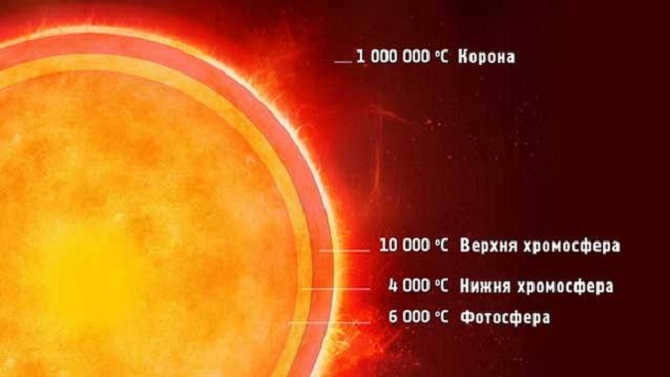
There are several surface layers of the Sun, including the photosphere, lower chromosphere, upper chromosphere, and corona.
The surface layer of the Sun has an average temperature of around 5000°C. Dark spots on the photosphere have lower temperatures, reaching up to 2000 degrees Celsius. Conversely, solar flares are the hottest parts of the solar photosphere.
Next to the photosphere is the chromosphere, which is approximately 2000 kilometers thick and much hotter than the photosphere. This region is responsible for active processes that impact all objects in the solar system, including our Earth. It is in the chromosphere that well-known solar prominences, which are hot emissions of stellar matter, are formed.
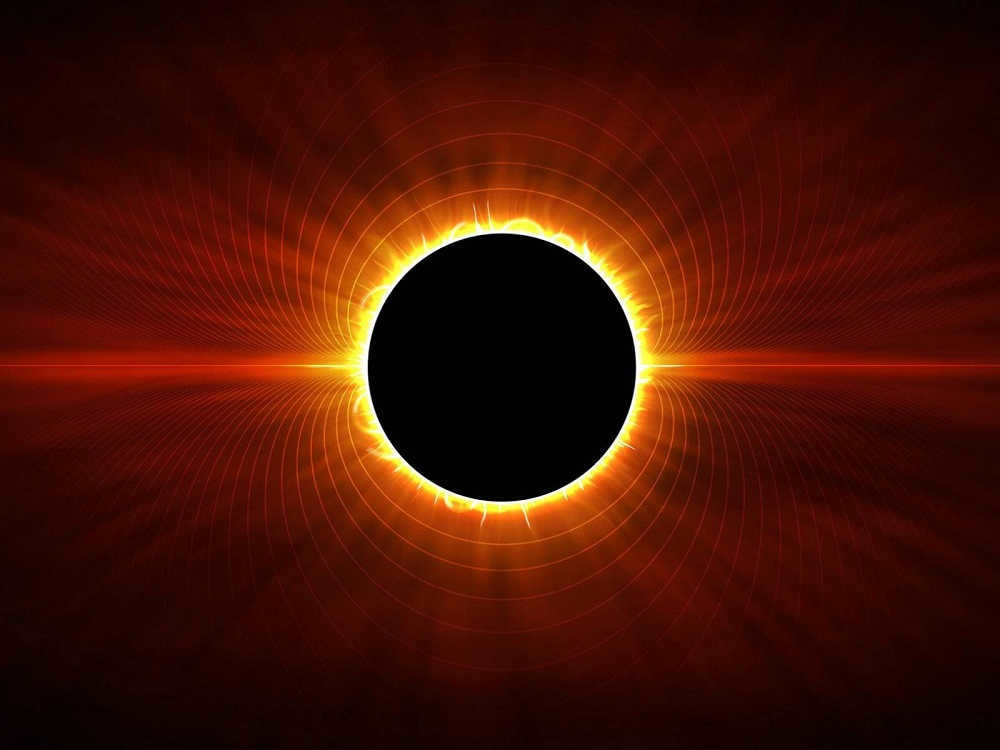
The corona is the primary distinguishing characteristic of a mature star.
The uppermost layer of a star’s atmosphere is known as the solar corona. It is characterized by extremely high temperatures, reaching up to a million Kelvin. As one moves further away from the boundary with the chromosphere, the temperature increases. At a distance of 70,000 kilometers from the Sun’s imaginary surface, the temperature of the ionized gas reaches two million Kelvin. The boundary of the corona can be clearly observed at a distance of 10-20 times the radius of the Sun.
The Sun’s Structure: An Overview
The Sun, our closest star, is a massive ball of hot, glowing gas. Its structure can be divided into several distinct layers, each with its own unique characteristics.
At the core of the Sun lies the central region, where nuclear fusion occurs. This is where hydrogen atoms combine to form helium, releasing a vast amount of energy in the process. The core is incredibly hot and dense, with temperatures reaching millions of degrees Celsius.
Surrounding the core is the radiative zone, where the energy generated in the core gradually makes its way outward. This zone is characterized by the transfer of heat through radiation. The energy travels in the form of photons, bouncing around and gradually making their way through the dense plasma.
Above the radiative zone is the convective zone, where energy is transferred through convection. In this zone, hot plasma rises to the surface, cools, and then sinks back down. This constant motion of plasma creates the Sun’s characteristic granulation pattern.
Finally, the outermost layer of the Sun is the photosphere. This is the visible surface of the Sun that we see from Earth. It is a relatively thin layer, but it is still incredibly hot, with temperatures around 5,500 degrees Celsius. The photosphere is also covered in sunspots, which are darker and cooler regions caused by magnetic activity.
Understanding the structure of the Sun is crucial for studying its behavior and the various phenomena it produces, such as solar flares and coronal mass ejections. Scientists use a combination of observations and models to gain a deeper understanding of this fascinating star.

The Sun’s composition consists of predominantly molecular hydrogen, which serves as its primary source of nuclear fuel. Helium makes up less than 25 percent of its composition, while nitrogen, carbon, and oxygen account for just one percent.
The Sun’s longevity is sustained by its vast reserves of hydrogen, which enable the ongoing process of thermonuclear fusion. This chain reaction, initiated billions of years ago, is fueled by the immense pressure generated by internal gravity. As long as this fusion continues, the Sun will continue to burn and thrive. The entire system remains in a stable and harmonious state. Through intricate chemical and thermodynamic processes, hydrogen undergoes atom splitting, resulting in the conversion of hydrogen into protons and electrons.
This procedure necessitates a great deal of force, which is 340 billion times greater than the force exerted by the Earth’s atmosphere. In order to initiate a thermonuclear response, a high temperature of 115 million degrees Celsius is required within the Sun’s core. The pressure exerted by the outer layers of the star is counterbalanced by the pressure emanating from the solar core. Otherwise, the material composing the star would collapse towards its central region.
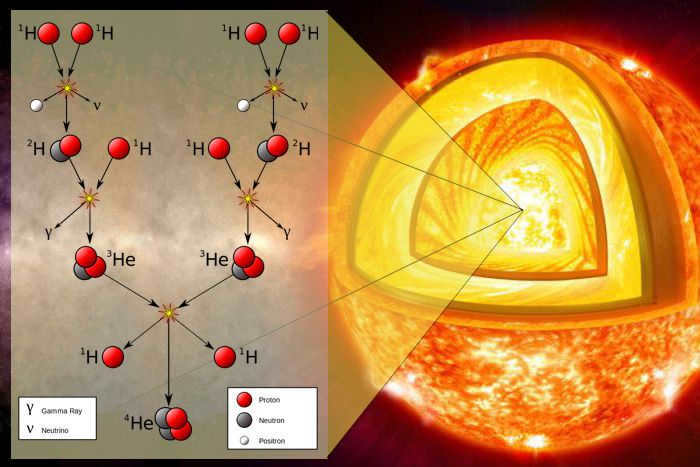
At a temperature of 10-14 million degrees Celsius, the reaction involving the burning of hydrogen is accompanied by various processes. These processes result in the formation of one helium nucleus from four hydrogen nuclei. This transformation is accompanied by a significant release of heat and light energy.
In approximately 4-5 billion years, assuming the Earth manages to endure the red giant phase, the Sun will reach a size comparable to that of our planet.






